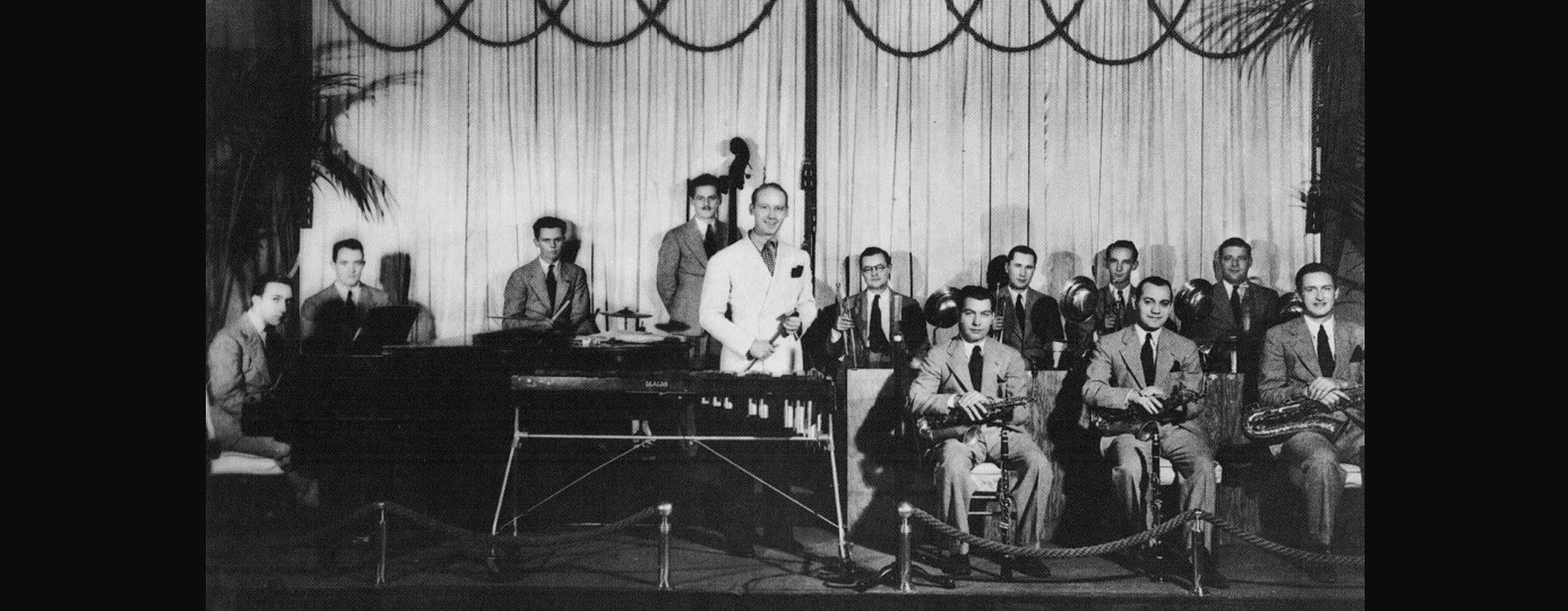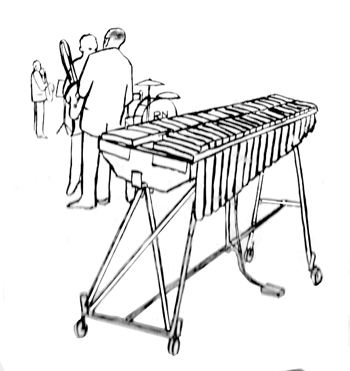

Photo: Red Norvo and his Orchestra circa 1936-37. Eddie Sauter (second from right, back row) playing trumpet as well as arranging. He stopped playing shortly thereafter to focus solely on arranging.
BELOW: Illustration from LP 'Red Norvo in Hi-Fi'.
It was during their shared time spent with Charlie Barnet's big band that Eddie Sauter and Red Norvo first came in contact. When Red Norvo started his own band in 1935, Sauter joined and put together a number of arrangements (in addition to playing on the group's first recordings in 1936).
In September of 1935, Norvo went into the Famous Door nightclub on 52nd Street with Stewie Pletcher on trumpet, Herbie Haymer on tenor saxophone, guitarist David Barbour, and Pete Peterson on string bass. The group originally lacked drums but had the writing of a young, tenacious Sauter to beef up the sound.
After the engagement at the Famous Door, the band moved across the street to the Hickory House. From the start on 52nd street, the band began to pick up steam and would eventually head out on tour nationwide.
Sauter wrote for "Mr. and Mrs. Swing," as the media referred to singer Mildred Bailey and Norvo from 1936 to 1942. Known for her incredible ear and impeccable diction, Mildred Bailey thrived in the well-structured arrangements that young Sauter provided. His early efforts revealed the arranger's ability to complement Bailey's voice with fitting instrumental backing.
In interviews, Sauter admitted that his frustration with the mercurial Bailey motivated him to write arrangements that were intended to throw off the seasoned singer.
One such arrangement that many critics have noted is "Smoke Dreams," recorded January 8, 1937. Replete with moments of polytonality and incredible dissonance, the introduction to the piece offers the singer no aid in finding the starting pitch. The accompaniment throughout offers equal amounts of striking dissonance, with punctuated crunch chords on every downbeat of the bridge.
Sauter often considered his willingness to take chances with his writing a result of the influence of the trumpet soloist in the Norvo band, Mr. Stewie Pletcher.
"I think I learned more jazz from Stewie because he would always try for things and miss, but it was his recouping that made the thing...To me most of the fun is reaching for something, not quite knowing where you're going and if you miss, use it; and I learned that from Stew, and I think that's an artistic precept."
Whatever the situation with the acoustics, the version of "Remember" recorded by Red Norvo's group that was in residency at the Blackhawk in March of 1937 stands out as one of the "fullest" sounding arrangements Sauter penned at that time.

Recommended: Listen on headphones or external speakers.
Red Norvo & His Orchestra
"Remember"
1937
See Music Analysis for "Remember"
"You Leave Me Breathless"
1938
THE 1936-37 BAND: Bill Hyland, Stew Pletcher, Eddie Sauter (trumpets); Al Mastren(trombone); Frank Simeone and Hank D'Amico (alto sax); Charlie Lamphere and Herbie Haymer (tenor sax); Joe Liss (piano); Dave Barbour (guitar); Pete Peterson (bass); Maurice Purtill (drums); Eddie Sauter (arranger); "Red" Norvo (xylophone, directing).
"...the version of "Remember" recorded at the Blackhawk in March of 1937 stands out as one of the "fullest" sounding arrangements [the 22-year-old] Sauter penned at that time." — Alex Chilowicz